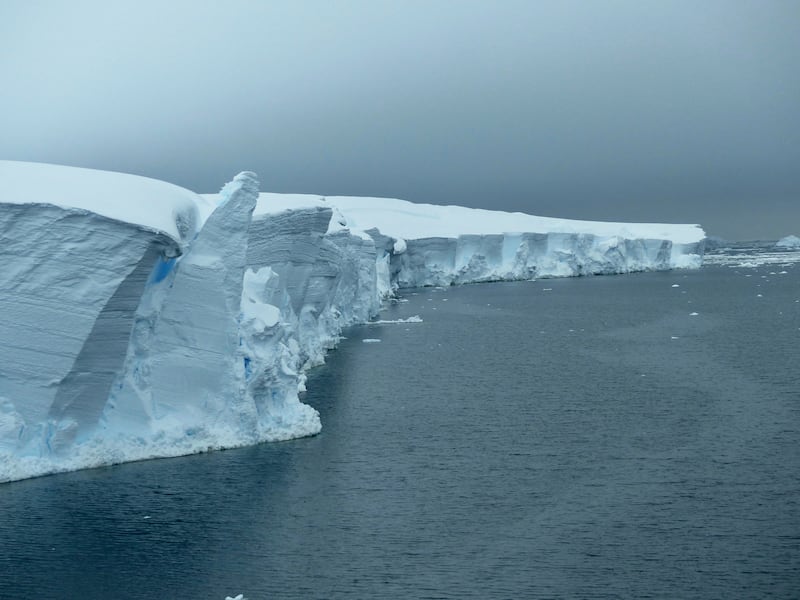The retreat of Antarctica’s Doomsday Glacier, so-called because its collapse could trigger a catastrophic rise in global sea levels, began in the 1940s after an extreme El Nino weather event, researchers have found.
Thwaites, the world’s widest glacier, is losing about 50 billion more tonnes of ice than it receives in snowfall, in an accelerating process first observed in the 1970s.
However, a study in the US has discovered the significant rate of melting actually began in the 1940s, about the same time the retreat of the nearby Pine Island Glacier began, probably due to an extreme El Nino that warmed the western Antarctic.
El Nino, which occurs every few years, is the warming of sea surface temperatures that typically occurs in the central-east equatorial Pacific.
The Thwaites glacier has not recovered since and is currently contributing to 4 per cent of global sea-level rise.
For that reason, the researchers say the current changes detected in Thwaites and Pine Island could have been set in motion in the 1940s.
“A significant implication of our findings is that once an ice-sheet retreat is set in motion, it can continue for decades, even if what started it gets no worse,” said James Smith, a marine geologist at the British Antarctic Survey and study co-author.
“It is possible that the changes we see today on Thwaites and Pine Island glaciers – and potentially across the entire Amundsen Sea embayment – were essentially set in motion in the 1940s.”
“It is significant that El Nino lasted only a couple of years but the two glaciers, Thwaites and Pine Island, remain in significant retreat,” said Julia Wellner, associate professor of geology and US lead investigator of the Thwaites Offshore Research project (Thor), an international collaboration whose team members are authors of the study.
“Once the system is kicked out of balance, the retreat is ongoing,” she added.
If the vast Antarctic ice sheet collapsed completely, scientists predict global sea levels could rise by 65cm.

The researchers measured levels of lead-210, a radioactive isotope naturally buried in sediment core to date the samples, and reached the conclusion that significant ice melt began in the 1940s.
Rachel Clark, a corresponding author of the report, said: “Lead-210 has a short half-life of about 20 years, whereas something like radiocarbon has a half-life of about 5,000 years,” she said. “That short half-life [of lead-210] allows us to build a timeline for the past century that’s detailed.”
The methodology is important because although satellite data exists to help scientists understand glacial retreat, images only go back a few decades.
Their findings also suggest retreat at the glaciers’ grounding zone, or the area where the glaciers lose contact with the seabed and start to float, was due to external factors.

“The finding that both Thwaites Glacier and Pine Island Glacier share a common history of thinning and retreat corroborates the view that ice loss in the Amundsen Sea sector of the West Antarctic ice sheet is predominantly controlled by external factors, involving changes in ocean and atmosphere circulation, rather than internal glacier dynamics or local changes, such as melting at the glacier bed or snow accumulation on the glacier surface,” said Claus-Dieter Hillenbrand, UK lead investigator of Thor and study co-author.
Ms Clark said the findings showed the change in the glacier was not random, nor specific to only the one.
“It is part of a larger context of a changing climate, you just can’t ignore what’s happening on this glacier,” she added.
The researchers said the Thwaites Glacier plays a vital role in regulating the West Antarctic ice sheet stability and global sea-level rise.
“The glacier is significant not only because of its contribution to sea-level rise but because it is acting as a cork in the bottle holding back a broader area of ice behind it,” Prof Wellner said.
“If Thwaites is destabilised, then there’s potential for all the ice in West Antarctica to become destabilised.”
Tipping point
Global temperatures are now warming so rapidly and the polar ice is retreating so quickly that scientists at the British Antarctic Survey have warned the world could have already reached a tipping point.
That spells bad news because currents that circulate around the world are directly influenced by the Antarctic.
Advancing on a 120km front at about 2km a year, Thwaites, also known as the Doomsday Glacier, has been the subject of a major investigation since 2020, when scientists found its movement led to warmer seawater flowing underneath it for the first time.
It is now predicted a catastrophic collapse could happen as soon as five years – or within 500 years.







